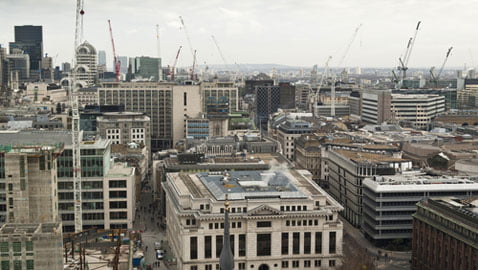UK commercial property’s attractive yield profile and steady returns continue to attract a broad range of investors. Investment volumes into the asset class increased by 49% to £58 billion in the year to 30 June, according to research by commercial real estate services firm Cushman & Wakefield. Around 40 per cent of this capital flow came from overseas.
Economic growth
A strengthening economy – the International Monetary Fund predicts that the UK will be the fastest growing developed economy in 2014 – relative political stability, an improving employment market and a capital city that remains a global financial and logistical hub are some of the UK’s many attractions for overseas investors.
The breadth, depth, liquidity and maturity of the commercial property market further strengthen the investment case.
Global investment
Foreign investment still remains concentrated on London, particularly the Central London office market. As the graphic shows, the US and the Far East were the dominant overseas investors into the UK commercial property market in the first half of 2014. In the same period, London was the most popular global city for Chinese institutional investment following the flow of £1.4 billion into the asset class.
Regional investment
Overseas investors have tended to be cautious when it comes to investing in regions outside of London and, to a lesser extent, the South East. Around 15% of overseas investment into the asset class was used to acquire regional properties during the last five years.
Alternative assets
Competitive pricing, limited supply, rising demand and yield compression, however, has led to demand growing outside of London and the South East. Foreign investment into UK regional property rose to 20% in the first half of 2014. This has forced traditional buyers to become innovative, which has seen a growing demand for alternative assets, such as private healthcare, hotels and student housing.
These specialist assets are often higher yielding than the prime office, retail and industrial sectors and lease lengths can be 20 years or more, giving good duration of income. These reasons, combined with an ageing domestic population, no doubt helped persuade a Wall Street hedge fund to acquire 27 elderly care homes spread across Britain earlier this year.
Strengthening market
Should investors be concerned about the weight of overseas money entering the market? With the forecast return to health of the UK economy and a strengthening occupier market, we do not believe so.
Commercial property returns are expected to be underpinned by rental income and the potential for some capital growth, particularly in the regions given that London has already seen significant gains. Rental value growth is expected to take over as the driver of returns in the longer term. This is expected to be particularly strong in London and the South East based on strong occupier demand pushing up rental values in key locations.
Ainslie McLennan is head of the retail investors’ franchise for commercial property at Henderson Managed Investment Trusts and Investment Companies
















